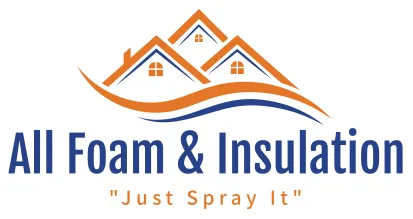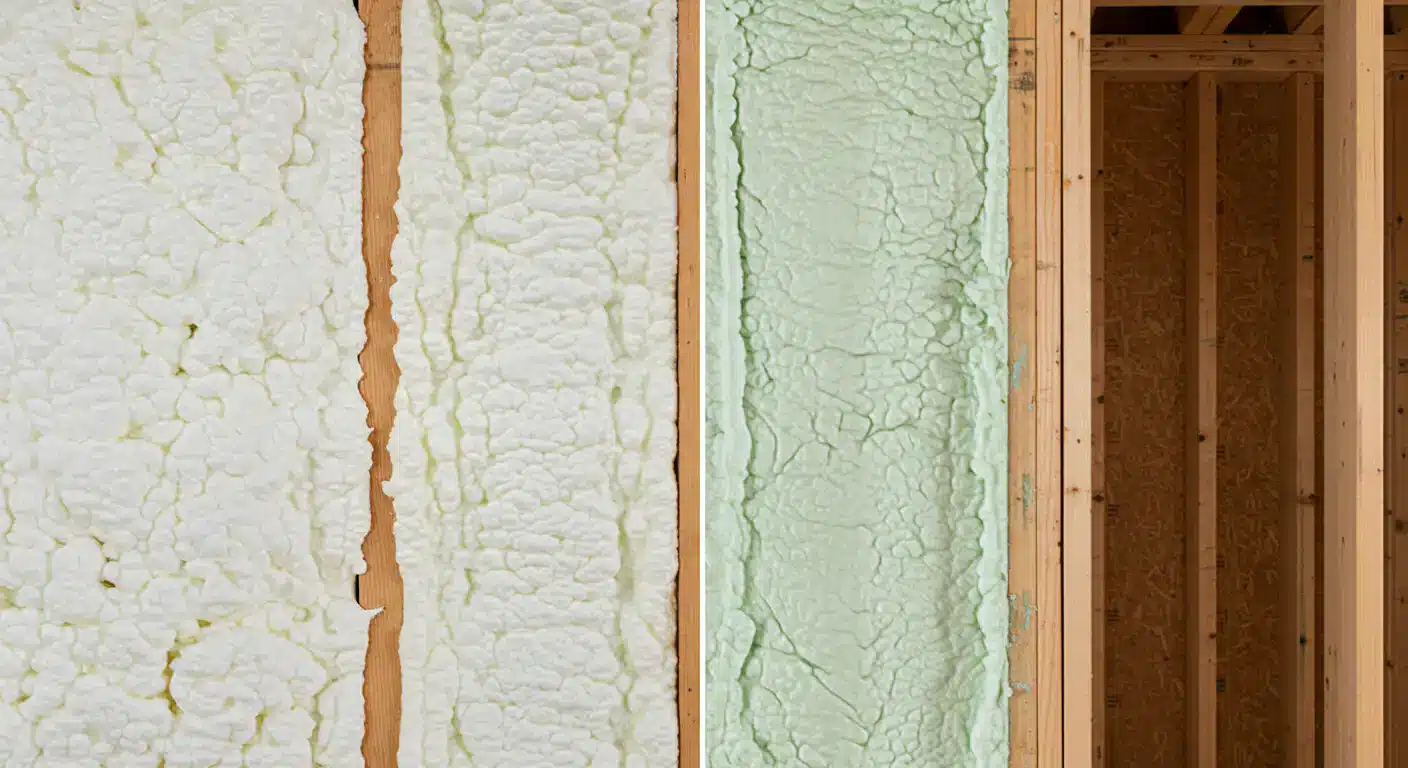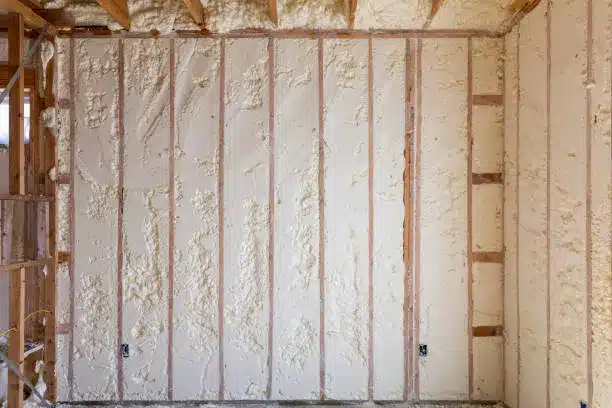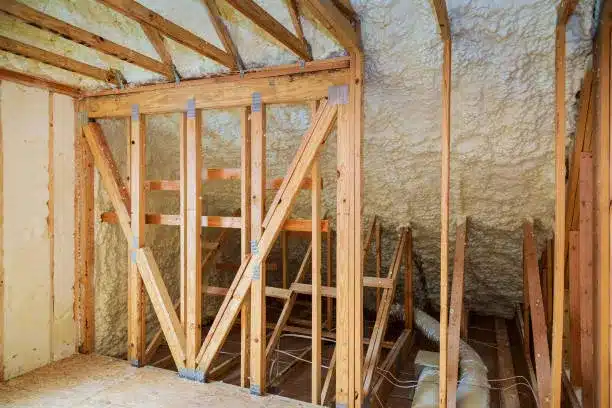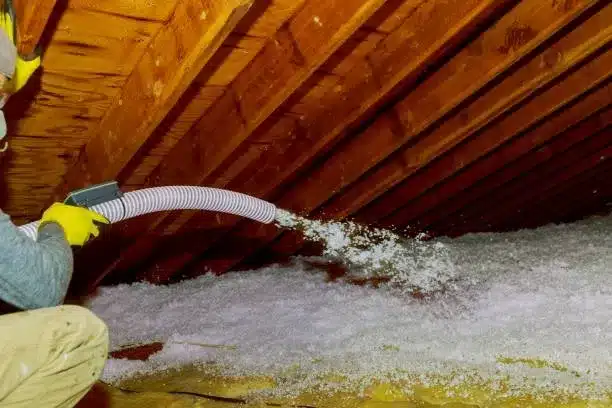Spray foam insulation is a popular choice for residential and commercial buildings due to its thermal resistance and air-sealing properties. It comes in two primary types: open-cell and closed-cell. Each has distinct characteristics that make it suitable for different applications. Understanding these differences helps property owners choose the best option for their needs.
Structure and Composition
Open-Cell Foam
Open-cell insulation consists of tiny cells that are not completely closed, allowing air to fill the spaces. This results in a soft, flexible material that expands significantly upon application. The lower density of open-cell foam contributes to its breathability and ability to manage moisture effectively.
Closed-Cell Foam
Closed-cell insulation features densely packed cells that form a rigid structure. The trapped gas within these cells enhances its thermal resistance, making it a highly effective insulator. Its rigid nature adds structural integrity to buildings and provides superior moisture resistance.
Thermal Performance
R-Value Comparison
The R-value measures an insulation material’s ability to resist heat flow. Closed-cell spray foam typically has an R-value of about 6 to 7 per inch, whereas open-cell foam has an R-value of 3.5 to 4 per inch. This means closed-cell foam provides higher insulation performance in a thinner layer, making it ideal for tight spaces.
Energy Efficiency
Both types of spray foam insulation improve energy efficiency by reducing air leakage. However, closed-cell foam offers a better barrier against heat transfer, making it more effective in extreme climates. Open-cell foam still provides substantial energy savings, particularly in areas where moisture control is a priority.
Moisture Resistance and Air Sealing
Water Absorption
Open-cell foam can absorb moisture due to its porous structure. While it does not retain water permanently, it allows vapor to pass through, making it useful in applications where breathability is needed, such as attic insulation.
Closed-cell foam, on the other hand, is highly resistant to water absorption. This makes it an excellent choice for areas prone to high humidity, such as basements or crawl spaces, where moisture control is critical.
Air Sealing Capability
Both types of foam provide excellent air-sealing properties, reducing drafts and preventing outdoor air infiltration. Closed-cell foam, however, offers a tighter seal, which enhances its insulating performance and ability to block allergens and pollutants.
Structural Strength and Durability
Rigidity and Support
Closed-cell foam adds structural support to walls and roofs due to its dense composition. This can be beneficial in areas subject to high winds or seismic activity. Open-cell foam remains flexible and does not contribute as much to structural reinforcement.
Longevity
Both insulation types have long lifespans, often lasting as long as the building itself. Closed-cell foam’s resistance to moisture and higher R-value make it less susceptible to degradation over time.
Cost and Installation Considerations
Material and Installation Costs
Open-cell foam is generally more affordable than closed-cell foam, both in terms of material cost and installation. Since it expands significantly, it requires less material per square foot, making it a cost-effective option for large areas.
Closed-cell foam, while more expensive, provides higher insulation value per inch. The added structural benefits and moisture resistance often justify the higher upfront investment, particularly in commercial or extreme climate applications.
Application Suitability
- Open-cell foam is ideal for attics, interior walls, and soundproofing applications.
- Closed-cell foam works best for exterior walls, foundations, basements, and areas exposed to moisture.
Choosing the Right Insulation for Your Project
Selecting between open-cell and closed-cell foam depends on specific needs, climate conditions, and budget. If moisture resistance and structural support are priorities, closed-cell foam is the better choice. For areas where sound dampening and cost savings are more critical, open-cell foam is a suitable option.
Expert Guidance for Insulation Solutions
For professional insulation advice tailored to your property’s needs, contact All Foam & Insulation, LLC at (541) 826-9600 or email [email protected]. Our team specializes in spray foam applications, ensuring the best insulation performance for your space.
Environmental Impact
Sustainability and Energy Savings
Both open-cell and closed-cell insulation contribute to energy efficiency, reducing overall energy consumption. However, closed-cell foam’s higher R-value translates to lower heating and cooling costs over time.
Green Building Considerations
Many modern spray foam products use environmentally friendly blowing agents with lower global warming potential (GWP). When selecting insulation, it’s important to consider formulations that align with green building standards.
Frequently Asked Questions
Which type of spray foam insulation is better for soundproofing?
Open-cell foam is superior for soundproofing due to its softer structure, which absorbs sound waves more effectively.
Can I use spray foam insulation in existing walls?
Yes, both open-cell and closed-cell foam can be installed in existing walls through injection methods, though open-cell foam is more commonly used for retrofits.
How does spray foam insulation impact indoor air quality?
Properly installed spray foam improves indoor air quality by reducing air leaks and preventing the infiltration of allergens, pollutants, and moisture.
Is spray foam insulation safe?
Once cured, spray foam is safe and does not emit harmful chemicals. However, during installation, proper ventilation and protective gear are necessary.
Does closed-cell foam prevent mold growth?
Yes, closed-cell foam resists moisture absorption, reducing the conditions that lead to mold and mildew growth.
What is the lifespan of spray foam insulation?
Spray foam insulation can last 50 years or more, provided it is installed correctly and remains protected from physical damage.
Will spray foam insulation increase my home’s value?
Yes, improved energy efficiency and comfort can enhance a home’s resale value.
Can I install spray foam insulation myself?
While DIY kits are available, professional installation ensures proper expansion, adhesion, and safety compliance.
How does spray foam compare to fiberglass insulation?
Spray foam provides superior air sealing, higher R-value, and better moisture resistance compared to fiberglass batts.
Does spray foam insulation require maintenance?
Spray foam is low-maintenance, but periodic inspections help ensure it remains effective over time.
For expert insulation solutions, reach out to All Foam & Insulation, LLC at (541) 826-9600 or email [email protected] to discuss your project requirements.

